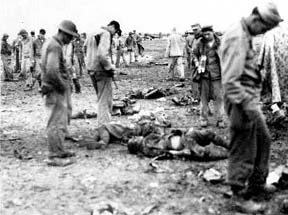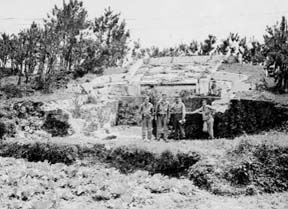On May 5th one of our TBM Grumman Avengers, piloted by Lieutenant
Joe Oliver, was struck in the right wing by a burst from a japanese
artillery shell. This burst damaged the right wing making it
unsafe to bring aboard the carrier for a landing. The option
was to land at Yontan airfield that had been taken from the enemy
and was now being used by the Americans. Joe landed safely and
was to spend the night at the field with his crew before being
picked up by one of the other TBMs from our carrier and returned
to the Petrof Bay. The plane remained at Yontan.

Lt. Joe Oliver and his damaged TBM |
Just by coincidence it happened to be the day that the
Japanese attacked the airfield with six bombers, each loaded
with twenty soldiers. Four of the bombers were shot down before
they could land and a fifth crashed on the field. All hundred
troops and pilots were killed. The sixth crash landed on the
runway where the twenty troops spewed out throwing hand grenades
and firing rifles. They succeeded in destroying several American
planes before being |
exterminated by the base Marines. In spite of the fire works,
there were no American personnel killed or wounded.
While all this was going on Lieutenant Oliver and his crew, not
being equipped to do combat took off for the woods to watch the
fire works. The next day Joe and his crew returned to the carrier
and were once again back on the flying schedule. A time exposure
photograph showing the fireworks that
evening is included at the end of this story.
|
During one of our DSG missions we were given a number from
our grid maps and requested to strafe and fire rockets into this
area as there was reported to be camouflaged vehicles and other
enemy equipment there. We made several runs on the area but were
unable to see much of anything because of the camouflaging and
the dense jungle. I could see fire and smoke from the area but
could not see what was burning. The |

Attack on Yontan airfield |
skipper told the three of us to circle while he went in for a
closer look. He had barely passed over the area when little black
clouds began to appear behind his plane. At the same time he
could see tracer bullets flying past his plane. We called for
him to get the hell out of there but it was unnecessary, he was
well on his way. Never did find out what damaged we caused, but
we were thanked and given a "Well done!" by the coordinator
on the ground.
One of Wells' photo reconn flights was to do a strip photograph
of the shore line and cliffs of the small island of Miyako Jima
for the purpose of determining the strength of the fortifications.
I was flying as his fighter escort. He was ordered to deliver
the exposed film to the operations officer at Kadena airfield
on Okinawa. After we landed and delivered the film Wells thought
it would be a good idea to take a tour of the local area that
had already been secured. Somehow he managed to get a jeep with
a Marine lieutenant for a guide. There wasn't much to see on
this tour but a few native Okinawans. They were the old and the
young and were contained in a wire enclosure. They certainly
didn't appear to be much of a threat to anyone's safety.

Okinawa cemetery crypts - Lt. R. Friedrick,
Ensign J. Wells, Marine Lt., Airmen Fielder |
The thing that makes the trip interesting were the burial
tombs. These tombs were constructed of rock in the side of a
hill which we could see from the air. They at first appeared
to be some kind of fortification and I have no doubt had received
considerable explosive attention. These tombs were quite old
and contained the ashes of the local former residents. Wouldn't
you know that Wells would have to have one of the urns from one
of the tombs for a souvenir. He crawled through a small opening,
selected the one he wanted, dumped the ashes and hauled the urn
back to the ship. Unfortunately for Wells, Doc Starr tossed the
thing over the side of the ship for health and safety reasons. |
For a period of eight days during May our carrier and another
were assigned to protect a fleet of oil tankers while they cruised
north to about 200 miles off the Japanese coast where they were
to refuel the "Fast Fleet". On this cruise just at
dusk, a Japanese mine came floating through the formation of
tankers and just a short distance off our port side. We stood
on the flight deck and watched it pass by as a destroyer escort
shadowed it. Once astern of the formation of ships, the escort
opened fire and exploded it while still in our view.
It was on this cruise with the tankers that we were invaded by
a pod of whales too. There were several of them and they were
more or less laying on the surface of the water and kind of laced
through the formation of ships. Even though they were among a
lot of ships, none were hit. The ships didn't change their course
nor did the whales.
The object of this escort duty was for the TBM pilots to fly
antisubmarine patrols. They were to fly 200 miles out on one
course do a 50 mile cross leg and fly back to the ship. On one
of these legs there was a very small island held by a small detachment
of Japanese soldiers. The island was too small for an airstrip
so there were no plans to capture it. Our pilots were told to
stay clear as these guys were armed and would shoot. The pilot
who got the segment nearest the island was Jim Wells. He had
his own ideas. He took the squadron photographer with him and
sure enough, he flew over the island. Nothing happened the first
pass so he tried for two. Yes indeed! They opened up on him and
punched several holes in his plane. |
|
|